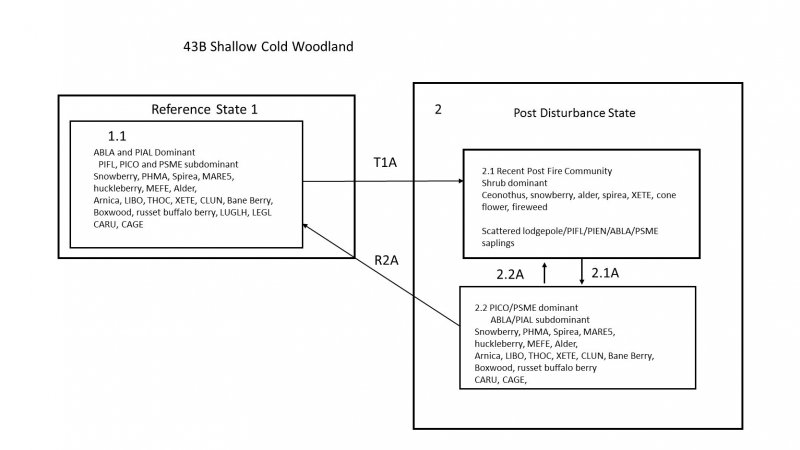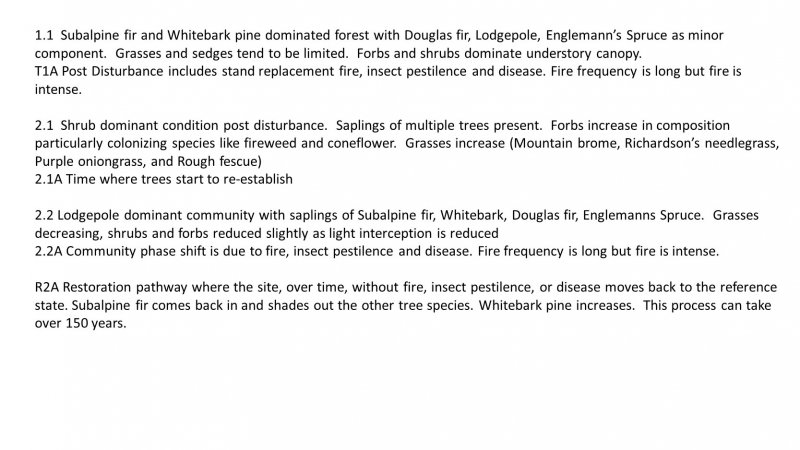
Natural Resources
Conservation Service
Ecological site F043BP902MT
Shallow Cold Woodland Group
Last updated: 3/01/2024
Accessed: 12/21/2025
General information
Provisional. A provisional ecological site description has undergone quality control and quality assurance review. It contains a working state and transition model and enough information to identify the ecological site.
MLRA notes
Major Land Resource Area (MLRA): 043B–Central Rocky Mountains
The Central Rocky Mountains (MLRA 43B) of Montana occupy some 28,850 square miles and exist primarily in Central and SW portions of the state. The climate is extremely variable with precipitation lows of 9 to 100 inches per year and frost free days of less than 30 to over 110 days. The geology of the region is also highly variable. The combination of variable climate and geology create a complex relationship of plant communities. MLRA 43B elevations typically exist between 6000 and 12,799 at Granite Peak (the highest point in Montana).
The Continental Divide runs through this MLRA effectively splitting its watershed to contribute to either the Missouri River to the East and the Columbia River to the West.
Ecological site concept
• Dominant Cover: Coniferous Forest
• Site does not receive any additional water
• Soils are
o Not saline or saline-sodic
o Not strongly or violently effervescent within surface mineral 4”
o Soil is shallow (less than 20in (50cm) to bedrock, lithic, or paralithic root restriction)
o Soil is not ashy or medial textural family
o Stones and boulders cover <15% surface area
• Soil surface texture variable (often loamy to sandy loam)
• Site Landform: mountain slope, ridges, cirques, escarpments
• Area of rugged mountain, hills, plateaus, and valleys of the Central Rocky Mountains in Southwest Montana.
• Parent material is variable
• Moisture Regime: udic
• Temperature Regime: cryic
• Elevation Range: 5800-10000 ft
• Slope: 2-30% (typically less than 15%)
Associated sites
| F043BP909MT |
Upland Cold Woodland Group The Upland Cold Woodland site is adjacent to the Shallow Cold Woodland however tending to be lower on the landscape where soils tend to be deeper. These two sites share similar plant communities and state and transition models. |
|---|---|
| F043BP916MT |
Ashy Cold Woodland Group The Ashy Cold Woodland site is adjacent to the Shallow Cold Woodland however tending to be lower on the landscape where soils tend to be deeper. These two sites share similar plant communities and state and transition models. |
Similar sites
| F043BP909MT |
Upland Cold Woodland Group The Upland Cold Woodland site is adjacent to the Shallow Cold Woodland however tending to be lower on the landscape where soils tend to be deeper. These two sites share similar plant communities and state and transition models. |
|---|---|
| F043BP916MT |
Ashy Cold Woodland Group The Ashy Cold Woodland site is adjacent to the Shallow Cold Woodland however tending to be lower on the landscape where soils tend to be deeper. These two sites share similar plant communities and state and transition models. The core species quantity is higher in the Ashy Cold Woodland. |
Table 1. Dominant plant species
| Tree |
(1) Abies lasiocarpa |
|---|---|
| Shrub |
(1) Symphoricarpos |
| Herbaceous |
(1) Carex geyeri |
Click on box and path labels to scroll to the respective text.

